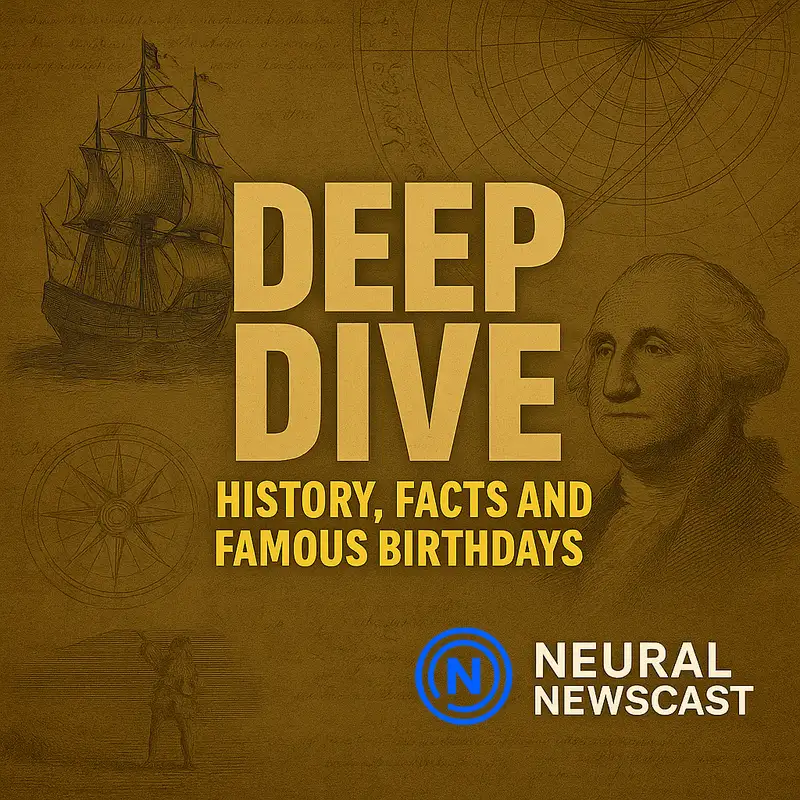Deep Dive: From Blue Jeans to Birthdays: A Denim Day Deep Dive - May 20, 2025
Your headlines, synthesized and verified.
This is Neural Newscast.
Welcome to Neural Newscast Deep Dive.
I'm Cassandra and with me is Lena.
Today we're exploring some fascinating topics.
On this day in 1873, Lena Levi Strauss and Jacob Davis
were granted a patent that would forever change the world of fashion,
and quite literally the way we dress.
It was the birth of what we now know as blue jeans.
Absolutely, Cassandra.
It's fascinating to think about how genes, which began as a simple work
where solution for miners evolved into a global wardrobe staple.
What initially started as a response to practical needs ended up crossing cultural and social boundaries.
That's a key point. Initially, the reinforced rivets were a solution for durability.
Miners and laborers needed something tougher than the traditional work pants,
and those copper rivets provided just that.
It's a prime example of necessity being the mother of invention.
Indeed. And it's not just about the practical appeal.
Jeans have this incredible chameleon-like quality, adapting to every era's aesthetic.
From the rebellious youth movements in the 50s and 60s to high fashion runways today,
denim has managed to stay relevant in every cultural shift.
And let's not forget the economic impact, Lena.
The patent was a catalyst for what became a massive industry.
The global denim market is worth billions today.
It's a testament to how a single innovative idea can ripple through economies and societies.
Yes, the economic story is huge.
But I also find it interesting how jeans became a canvas for self-expression.
In the 70s, you had people personalizing their denim with patches and embroidery during the counterculture movement.
In many ways, it became a wearable art form.
That's a beautiful way to put it.
Even in political spheres, genes have been symbolic.
They've been worn as a statement of solidarity or rebellion across various movements,
embodying democratic ideals of equality and freedom.
It's rare for a piece of clothing to hold such significance.
And their cultural significance continues to evolve.
Today, jeans are a part of sustainable fashion conversations.
Brands are innovating with recycled denim and eco-friendly practices,
showing that even a classic like blue jeans can adapt to new societal values.
It's almost poetic, really.
What started as a rugged necessity has become a versatile icon, mirroring the changing tides of society
From humble beginnings in 1873 to today's high-tech innovations,
blue jeans tell a story of endurance and adaptation.
They truly do, Cassandra.
It's a reminder that the garments we choose to wear often carry stories far beyond their seams,
stitching together history, culture, and economy in ways we might not always consider.
Today we celebrate the birthdays of Edith Head, 1897, Eleanor Roosevelt, 1884, and Desmond Tutu, 1931.
What a fascinating lineup!
Let's dive into Eleanor Roosevelt.
I've always admired how she reshaped the role of the First Lady.
Her work went far beyond the traditional social responsibilities, didn't it?
Absolutely, Lena.
Eleanor was a trailblazer in every sense.
As First Lady, she transformed the role into a platform for advocacy.
Her regular newspaper column, My Day, was remarkably progressive for the time.
She used it to address pressing social issues and connect with the public directly.
It was like the original blog.
And let's not forget her work with the United Nations after FDR's presidency.
She was the driving force behind the Universal Declaration of Human Rights.
Her contributions laid the groundwork for human rights advocacy as we understand it today.
Quite a legacy, don't you think?
Indeed, her tenure as the chair of the UN Human Rights Commission was groundbreaking.
But what I find equally compelling is how she championed civil rights well before it became
a national priority.
She frequently invited African-American leaders to the White House and publicly supported anti-lynching legislation, which was quite controversial at the time.
That's right. And Eleanor had a knack for connecting with people of all backgrounds.
Her empathy was her superpower.
She even held press conferences exclusively for female reporters challenging the norms of her era.
She was a good.
It was her persistent curiosity and commitment to learning that kept her relevant across decades.
Eleanor would often travel unaccompanied seeking first-hand experience of issues.
These travels informed her advocacy and helped her gain a deeper understanding of the world's complexities.
Her educational journey was pivotal too.
Being taught by Marisa Vester, a progressive educator instilled in her a lifelong drive for social justice.
That early influence was crucial, wouldn't you say?
Definitely.
Sylvester's impact on Eleanor's outlook can't be overstated.
It's a reminder of how vital early education and mentorship are in shaping future leaders.
Eleanor's life was a testament to the power of using one's platform to enact meaningful change.
Her legacy is still felt today.
Current generations continue to draw inspiration from her work.
Women in politics and advocacy often cite Eleanor as a key influence.
It's amazing how her vision for a more equitable world persists.
Yes, her legacy is enduring.
Eleanor Roosevelt's life was a powerful narrative of transformation, advocacy, and resilience.
It's no wonder she remains a beacon for those striving to create a more just society.
Time for a quick pause.
We'll explore more when Neural Newscast DeepDive returns.
Stay ahead with NNC, Neural Newscast.
Subscribe, share, and revisit our archives at NNewscast.com.
Welcome back to Neural Newscast Deepdive.
Let's continue our exploration.
Did you know that the phrase clean as a whistle originated from the perfectly smooth bore of an early 19th century gun barrel?
It's fascinating how language evolves, isn't it?
Absolutely, Cassandra.
What I love about this phrase is how it straddles science and art both in its origin and its adaptation into everyday language.
Picture it, the craftsmanship required to create such precise smoothness in an era without modern machining.
It's practically an art form.
Right, Lena, and the notion of clean here is intriguing too.
In politics, clean efforts often imply transparency and deficiency.
But as we've seen, achieving this in governmental processes is anything but straightforward.
There's a delicate ballet involved, balancing regulations and public opinion.
It's similar in the cultural sphere, where maintaining the integrity of an art movement requires a certain purity of vision.
Yet, as with politics, there's always the friction of external influences, commercial interests, societal expectations that can muddy the waters.
It's a dance of intention versus reality.
Exactly. And if you think about it, the term clean as a whistle could also imply in absence of hidden agendas, a trait we often chase in our political leaders.
But as history shows us, that kind of transparency is as rare as a perfectly polished antique firearm.
That's a great point.
In cultural contexts, a movement or piece of art that remains clean or true to its origin can often be mistakenly perceived as simplistic.
In reality, it's the result of complex decisions, much like the meticulous work of crafting a gun barrel.
It's no wonder why we sometimes romanticize these clean beginnings.
And yet, just as a spotless whistle may not always produce the expected sound.
Political strategies, while seemingly transparent, might yield unexpected outcomes.
There's always an element of unpredictability.
Unpredictability indeed.
And yet, that's what makes both political and cultural landscapes so thrilling to explore.
Just when you think you've reached clarity, a new angle or influence shifts the perspective,
much like the whistle's sudden change in pitch.
It's a reminder of the ever- iterative nature of both fields.
Policies need constant refinement to stay relevant,
just as art continually evolves to reflect or challenge societal norms.
Which circles us back to the beauty of language, doesn't it?
That a simple idiom like Clean as a Whistle can carry such rich, multifaceted meanings,
meanings that continue to evolve with our societies.
a linguistic relic that's both historical and timeless, reminding us of the complexities beneath
the surface. Just as in politics and culture, it pays to dig deeper, wouldn't you agree?
I couldn't agree more, Cassandra. Whether it's crafting legislation or a masterpiece,
the quest for clarity and authenticity is both an art and a science, and that's what keeps our
world so endlessly captivating.
Thanks for tuning into our deep dive.
I'm Lena and from Cassandra and the Neural Newscast team.
We'll see you next time.
That wraps up today's journey through time on NNC.
Neural Newscast.
Discover more stories and daily news episodes at our website, nNewscast.com.
Neural Newscast integrates real and AI-generated voices
to facilitate efficient, high-quality news production.
Developed by human experts, our AI-generated content undergoes rigorous fact-checking and human review before publication.
While we strive for accuracy and neutrality, AI-generated content may occasionally contain errors.
We encourage listeners to verify crucial details from reliable sources.
For more on our AI transparency practices, visit newscast.com.
Creators and Guests



